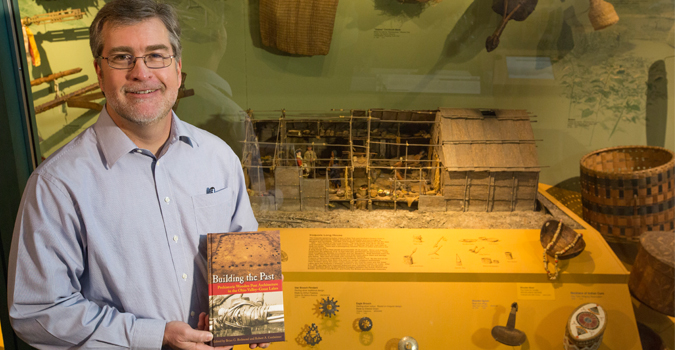Book Sheds Light on Ancient Architecture
A new book digs into the past to examine the architecture of ancient houses and structures in the Ohio Valley and Great Lakes. Curator of Archaeology Dr. Brian Redmond, John Otis Hower endowed chair of archaeology, co-edited the volume. Titled Building the Past: Prehistoric Wooden Post Architecture in the Ohio Valley—Great Lakes, the book consists of 11 chapters describing the excavations and analyses of Native American buildings found as far south as Kentucky and north through Ohio and Indiana to Ontario.
These detailed accounts—never before published—reveal the diversity of wooden post constructions and the ingenuity the region’s native peoples over a period of 6,000 years prior to European contact. The book illustrates how building methods changed over the millennia and were tailored to the specific needs of local societies. Many of the studies demonstrate that native architectural methods were much more sophisticated than previously thought and served diverse functions from private housing to huge religious gatherings.

The earliest structures explored include pit houses from Ontario and small wooden post huts across Ohio dating from 6,000 to 3,000 years ago. Most of these structures housed small family groups during various seasons. New evidence from some sites points to the construction of many houses at one time, which indicates the development of village settlements much earlier than previously suspected.
The book discusses larger houses and ceremonial buildings belonging to the Early and Middle Woodland mound and earthwork-builders of Ohio. Square structures thought to house extended families served as the homes of Hopewell culture peoples living near modern Chillicothe, Ohio. These small groups of houses, called hamlets, were situated near the massive geometric earthwork enclosures that served as the ceremonial centers of the Ohio Hopewell people. Extensive excavations of large mounds within several of these enclosures revealed large buildings, referred to by former Museum archaeologist and curator Dr. N’omi Greber—for whom the book is dedicated—as “Big Houses.”
The final chapters of the book focus on the archaeological traces of elaborate architectural forms constructed during the final thousand years before European contact. Redmond and Brian Scanlan, the Museum’s supervisor of archaeology field programs, co-authored a chapter on the Late Woodland and Late Prehistoric residents of the Heckelman site in northern Ohio. The Late Woodland inhabitants built large, substantial houses for two or more families around AD 600. After a gap of some 800 years, a small population of maize farmers reoccupied the site and constructed pit houses for winter use and small rectangular dwellings for summer occupation.
The book is available for purchase from University Press of Florida and on Amazon.com.
This article was published in Explore Member Magazine, Volume 3, Number 2, Summer 2015